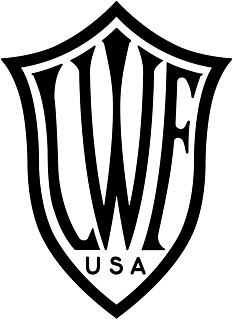
The Bréguet XIV or Bréguet 14 was a French biplane bomber and reconnaissance aircraft of World War I. It was built in very large numbers and production continued for many years after the end of the war.

The Aero A.14 was a Czechoslovakian biplane military reconnaissance aircraft built in the 1920s. It was essentially a slightly modified version of the Hansa-Brandenburg C.I aircraft that Aero had built during World War I as the Ae.10, and for this reason, the aircraft is sometimes referred to as the A.14 Brandenburg. When equipped with a slightly different engine, the aircraft was designated A.15 instead. The two versions were otherwise almost identical.

The Curtiss Models F made up a family of early flying boats developed in the United States in the years leading up to World War I. Widely produced, Model Fs saw service with the United States Navy under the designations C-2 through C-5, later reclassified to AB-2 through AB-5. Several examples were exported to Russia, and the type was built under license in Italy.

The Dorand AR.1 was a World War I French two-seat observation biplane aircraft used by the French Air Force, the American Expeditionary Force and, in small numbers, by Serbian Aviation.

The Colonial Model C-1 Skimmer was an American small single-engined amphibian flying boat built by the Colonial Aircraft Corporation. It was the start of a line of very similar aircraft designed by David Thurston.

The Lioré et Olivier LéO H-13 was a French biplane two-engine flying boat of the 1920s, built in passenger and military variants.

The Baumann Brigadier was a prototype American light transport aircraft of the late 1940s. It was a twin-engined monoplane, which, unusually, was of pusher configuration. Only two were built, plans for production never coming to fruition.

The Spartan C2 is a light aircraft produced in the United States in the early 1930s as a low-cost sport machine that would sell during the Great Depression.
The Williams-Cangie WC-1 Sundancer is an American homebuilt biplane racing aircraft that was designed by Art Williams and Carl Cangie and built by Ralph Thenhaus in 1974. Plans were at one time available from Williams' company, the Williams Aircraft Design Co of Northridge, California. Only one was built.

The Williams W-17 Stinger is an American homebuilt racing aircraft that was designed for Formula One Air Racing by Art Williams and produced by his company, Williams Aircraft Design of Northridge, California, introduced in 1971. The aircraft was at one time available in the form of plans for amateur construction, but only one was ever constructed.

The Aero Designs Pulsar is an American two-seat, low wing, ultralight and homebuilt aircraft that was designed by Mark Brown and first produced by Aero Designs of San Antonio, Texas, introduced in 1985. When it was available the Pulsar was supplied as a ready-to-fly aircraft and as a kitplane for amateur construction.

The Curtiss/Curtiss-Robertson Model 56 Thrush was a 1929 six passenger high-wing fixed undercarriage single-engine cabin monoplane airliner and utility transport powered by either a Curtiss Challenger or a Wright Whirlwind radial engine and built as an enlargement of the earlier Curtiss Robin. Several were used for record breaking endurance flights by female pilots during the early 1930s including one in which the aircraft stayed aloft for almost ten days.

The Lowe, Willard & Fowler Engineering Company was a College Point, New York City based manufacturer of airplanes founded in December 1915 named for its founders, Edward Lowe Jr., Charles F. Willard, and Robert G. Fowler,

The Brutsche Freedom 210 STOL was a proposed American STOL homebuilt aircraft that was designed by Neal H. Brutsche and intended to be produced by Brutsche Aircraft Corporation of Salt Lake City, Utah, introduced in the mid-1990s. The aircraft was planned to be supplied as a kit for amateur construction.

The TeST TST-5 Variant is a Czech homebuilt aircraft that was designed and produced by TeST Gliders of Brno, introduced c. 1998. When it was available the aircraft was supplied as a completely assembled aircraft, without engine or instruments, and also as a kit for amateur construction.

The Emsco B-8 was a two-seat, single-engine, low-wing, twin boom experimental aircraft designed by Charles F. Rocheville in 1930 while he was vice president of Emsco Aircraft Corporation, Long Beach, California.
The CSA PS-38 Tourer is a Czech light-sport aircraft under development by Czech Sport Aircraft of Prague, introduced at the AERO Friedrichshafen show in 2014. The aircraft is intended to be supplied complete and ready-to-fly.
The Rokospol Via is a Czech ultralight and light-sport aircraft (LSA), designed and produced by Rokospol Aviation of Prague, introduced at the Prague airshow in 2008. The aircraft is supplied complete and ready-to-fly.

The L-W-F Model H Owl was a large American twin-boom trimotor biplane designed and built by LWF Engineering as a mail plane in 1920, but after being rejected for that role, the single prototype was sold to the United States Army Air Service for evaluation as a bomber but failed to secure any orders.

The Praga E-51 is a Czechoslovakian reconnaissance aircraft and light bomber built by Praga in the 1930s. Development was halted by the annexation of Czechoslovakia by Germany, after only one prototype had been built. The appearance of the construction is very reminiscent of the contemporary twin engined fighter, the Fokker G.I from Holland.






















